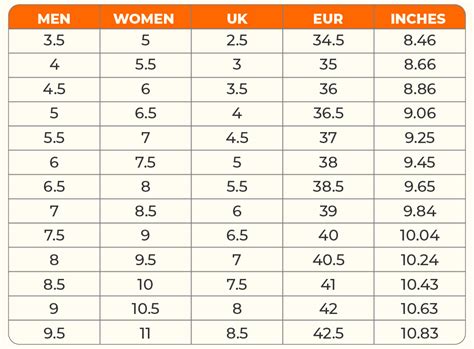Mens to Ladies Size Conversion Chart

When it comes to shoe sizes, the difference between men’s and women’s sizes can often be confusing, especially for those who are looking to purchase shoes online or are considering a unisex shoe option. Understanding the conversion between men’s and women’s shoe sizes is essential to ensure a proper fit. Here, we will delve into the intricacies of shoe size conversions, providing a comprehensive guide on how to convert men’s shoe sizes to ladies’ sizes accurately.
The Basics of Shoe Sizing
Shoe sizes are based on the length and width of the foot. In the United States, the most common system for measuring shoe sizes is the Brannock Device, which assigns a numerical value to the length of the foot and a letter to the width. For men and women, the scale differs due to the average differences in foot shape and size between genders.
Men’s to Ladies’ Size Conversion
Generally, to convert a men’s shoe size to a women’s size, you subtract 1.5 to 2 sizes from the men’s size. This method, however, may not be perfectly accurate for all brands and styles, as shoe size can vary significantly between manufacturers. Additionally, this conversion assumes a standard width, but feet come in various widths, and some brands offer wider or narrower options.
Here is a basic conversion chart to give you an idea:
| Men’s Size | Women’s Size |
|---|---|
| 6 | 7.5 to 8 |
| 6.5 | 8 to 8.5 |
| 7 | 8.5 to 9 |
| 7.5 | 9 to 9.5 |
| 8 | 9.5 to 10 |
| 8.5 | 10 to 10.5 |
| 9 | 10.5 to 11 |
| 9.5 | 11 to 11.5 |
| 10 | 11.5 to 12 |
| 10.5 | 12 to 12.5 |
| 11 | 12.5 to 13 |
| 11.5 | 13 to 13.5 |
| 12 | 13.5 to 14 |

Understanding Widths
In addition to length, shoe width is also an important factor. Widths are denoted by letters (for example, AA, A, B, C, D, E, EE, etc.), with ‘B’ being the standard width for women and ’D’ for men. When converting sizes, it’s also crucial to consider the width, as a men’s size with a narrower width might fit closer to the listed women’s conversion.
Tips for Accurate Conversion
Know Your Size: First, ensure you know your size accurately in your gender’s scale. If you’re not sure, getting your feet measured using a Brannock device can provide the most accurate measurement.
Check the Brand: Different brands can have slightly different sizing. Some may run larger or smaller than others, so it’s essential to look at the sizing chart for the specific brand you’re interested in.
Consider the Style: The style of the shoe can also affect the fit. For example, a sleek, sporty shoe might fit tighter than a loose, casual shoe.
Read Reviews: Looking at reviews from other customers, especially those who have also converted sizes, can provide valuable insights into the fit of the shoe.
Try Them On: If possible, try the shoes on before buying. This is the best way to ensure a good fit, especially if you’re converting between men’s and women’s sizes.
FAQ Section
What is the basic rule for converting men's shoe sizes to women's sizes?
+The basic rule is to subtract 1.5 to 2 sizes from the men's size to get the equivalent women's size.
Do all shoe brands follow the same sizing conversion?
+No, different brands can have slightly varying sizing standards. It's always best to check the brand's sizing chart for the most accurate conversion.
How does shoe width affect the conversion from men's to women's sizes?
+Shoe width is crucial in conversions because men's standard width (D) is wider than women's standard width (B). A narrower men's shoe might fit closer to the listed women's conversion size.
What is the best way to ensure an accurate fit when converting shoe sizes?
+The best way to ensure an accurate fit is to try the shoes on. If that's not possible, reading reviews from other customers who have converted sizes can be very helpful.
In conclusion, converting men’s shoe sizes to ladies’ sizes requires a bit of knowledge about shoe sizing systems and how different brands interpret these sizes. By understanding the basics of shoe sizing, considering the brand and style of the shoe, and using the conversion chart as a guide, you can find the perfect fit. Remember, shoe size is not just about the length but also the width, and different styles can fit differently. Always prioritize trying shoes on, if possible, and utilize the wealth of information available from brands and customer reviews to guide your purchase decision.


